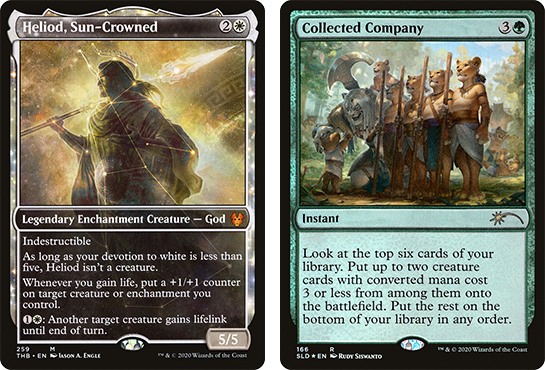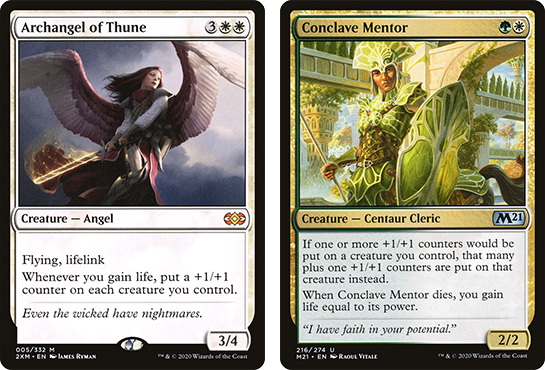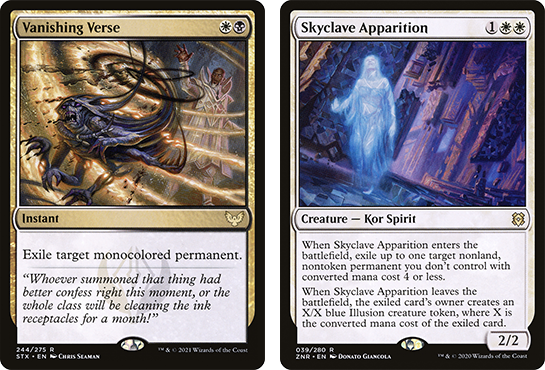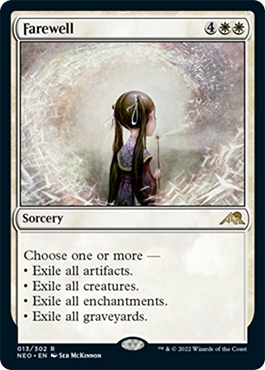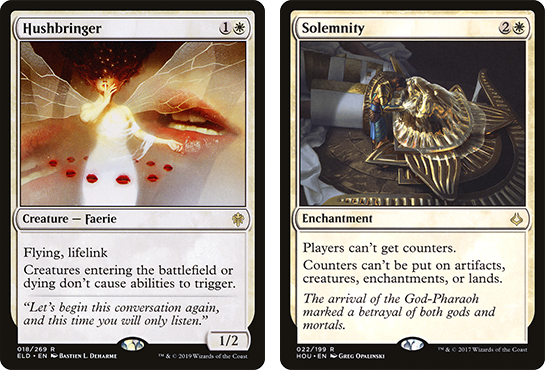Out of all the classic card effects in Magic, lifegain might get the least respect. And though it pains me to say it…with good reason. The problem with expending cards and mana to gain life – especially if that’s the only thing you’re doing – is that lifegain alone will never win the game for you, so all you’re doing is giving your opponent time to get ahead with THEIR gameplan. Whatever temporary buffer you establish yourself is unlikely to be worth the investment – even burn decks just don’t run out of gas by themselves in 2022.
Using a combo that gains a practically infinite amount of life is more effective, and might at least give aggro players a headache. But even that doesn’t guarantee you won’t lose by decking, and you give your opponent a lot of time to look for some tricky out. Besides, if you’re going to the trouble of assembling a combo, why would you use it just to gain infinite life? Isn’t it better to do infinite damage and win right there before your opponent can come back?
Well, what if you could just do both?
WHAT IS HELIOD’S COMPANY?
This archetype actually features a gaggle of related combos which share Heliod, the Sun-Crowned as their lynchpin and enabler. Which specific combos end up in a particular decklist can depend on format, colors, expected metagame or simply player preference. However, they all share enough key traits to make them fairly interchangeable when discussing high level strategy:
- They all rely on creating an infinite life loop with Heliod’s triggered ability – usually by finding a way to have each +1/+1 counter generate or pay for a new instance of lifegain.
- Since this loop also gives you an arbitrarily large number of +1/+1 counters on your creatures, many combo turns will also lead to then killing the opponent with damage – averting the inherent drawback of life combos.
- This is a creature-combo deck: all cards used in any version of the combo are creature cards. This can help with tutoring and recursion and means we can play proactively to the board even if the combo isn’t available yet.
What’s more, all the creatures involved are very cheap, coming in at three mana or less. Since Heliod Combo decks are mostly played in formats where Collected Company is legal, this powerful instant becomes one of the core reasons to play this combo over other decks. The possibility that a Heliod player could suddenly rip a lethal combo off the top of their deck at instant speed makes every decision difficult for the opponent and lets you overload enemy interaction in a flurry of creature cards!
MEET THE COMPANY
Here are the most prominent payoff options for Heliod’s Company, along with the main formats they’re played in and what unique properties they bring to the deck:
Walking Ballista + Heliod
(Played in: Modern, Pioneer)
Our starting point is the most straightforward and reliable way to turn Heliod’s +1/+1 counters into both further lifegain and lethal damage. It’s also very mana-efficient and one of the rare mono-white combo options. As soon as you resolve Heliod’s lifelink ability targeting your Ballista (or it gains lifelink from some other source) you can shoot for an easy win, since removing a counter from the Ballista to deal damage will also lifelink for one, triggering Heliod to reload the Ballista for you.
You will need at least a 2/2 Ballista to start the loop, since it doesn’t get the +1/+1 counter returned fast enough to stop it dying if it goes down to 0/0. This can be easily achieved by just paying more for Ballista, having an anthem or lord effect in play, or swinging with another lifelinker to generate an extra counter on Ballista before going off in your second main phase.
The mono-white Pioneer deck which popularized Heliod combo got creative with Metallic Mimic and even Idyllic Grange! Both of these allow a turn 4 kill by adding a “free” counter when you cast Ballista for X=1, leaving two extra mana to grant it lifelink from Heliod.
Spike Feeder + Heliod
(Played in: Modern)
This version of the combo is theoretically less powerful, since it “only” gains life without any other upside. Spike Feeder still has to pay a counter to generate each new Heliod trigger, like Ballista, but unlike ol’ Walky B, there’s no inherent way to convert that loop into victory.
The GW Heliod deck in Modern routinely plays Spike Feeder as a “backup combo” to Walking Ballista, which greatly increases the chances of having at least one loop going by turn three or four. This backup plan will mostly be important against Modern’s lightning-fast aggro decks – which of course are the situations where gaining a billion life is more or less a win anyway.
You can also add a third card to this loop to fully break it – something like Archangel of Thune or Conclave Mentor will let you supercharge every creature on your board to arbitrarily large stats and cruise to victory from there.
Scurry Oak + any “Soul Sister” + Heliod
(Played in: Historic)
Since WotC wisely remastered Walking Ballista out of Kaladesh before it could be added to Historic, you may think that you’re safe from Heliod combo in that MTGA-only format. But you’d be wrong, because they then gave the deck a fine alternate payoff in Jumpstart: Historic Horizons: Scurry Oak.
Granted, this version of the combo is slightly more involved, since Scurry Oak itself has no way to turn Heliod counters into more lifegain and proceed with the loop. But this can be made up for by adding Soul Warden, or another creature with a similar triggered ability – which many players shorthand as “Soul Sisters”. Now, every instance of lifegain will let Heliod put a counter on the Oak, which will make a Squirrel token, which will trigger lifegain from your Soul Sister (or halfling innkeep – I don’t judge you!), and the loop is complete.
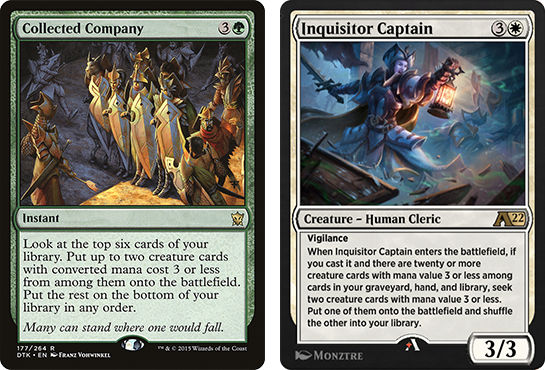
While a three-card combo is usually asking for trouble in cutthroat competitive environments, Collected Company plus the inherent survivability of a lifegain-and-tokens deck has made Historic Heliod a tournament winner. But for those still on the fence, this format also includes Inquisitor Captain – the closest thing you’ll get to having eight copies of “CoCo” in your deck. Just be careful you bring enough eligible targets – Captain’s effect doesn’t count creatures already in play, or those which get exiled earlier in the game!
HOW TO BEAT IT?
In my experience it is often inevitable that a Heliod deck will be able to put one of their combos together, and it might be better to hold instant removal back to break up whatever version they end up finding, lest you waste it early on a redundant or superfluous creature. Fighting Heliod’s Company on the stack is all about stopping the payoff creatures, as only a few decks are capable of killing an indestructible enchantment without sideboard cards.
Walking Ballista is the easiest payoff creature to disrupt, as the loop cannot proceed without first resolving Heliod’s activated ability or some similar lifelink-granting effect. The Ballista also needs to consider its “base” pool of +1/+1 counters, since Heliod only replaces those which are spent instead of accruing more as the loop proceeds. Granting lifelink with Heliod costs 1W. Walking Ballista will almost always start with at least the minimum two counters it needs to perform the loop, but might be larger in a longer game.
Whichever resource the Heliod player is shortest on – mana or counters – dictates whether you should play removal in response to the lifelink activation, or the first attempt to deal damage with Ballista. Spike Feeder and Scurry Oak don’t require the lifelink activation to combo, so just respond once the first instance of their abilities hit the stack.
You should rarely use removal before the Heliod player initiates their combo, because all the abilities involved on their side work at instant speed – they could simply go off and win the game right there, all with your Lightning Bolt stranded there on the bottom of the stack! So long as you let them move first and you have a spare piece of interaction for each additional combo attempt they can pay for, you’ll win out in the end. Just remember to count any other cards which can instantly generate life, counters or creatures as part of that math!
Also watch out for opponents who assemble the combo but don’t immediately try to win. They may try and wait you out until they can untap all their lands next turn or generate extra counters on their payoff creature with lifelink attacks. While it’s dangerous to risk them gaining a resource advantage this way, you still shouldn’t be baited into making the first move if they can kill you in response!
AN OUNCE OF PREVENTION
While instant removal is important to defend yourself from a combo in progress, these decks can be significantly set back by the use of sweepers to delay their combo turn. Unless they can slam two Collected Company before you untap again, they’re unlikely to fully rebuild their board – especially if you use a sweeper like Farewell which can also deal with Heliod.
The Historic version in particular suffers against these spells: Scurry Oak’s combo has to wait a turn to win with attacking squirrel tokens, and the nature of clicking through triggers on Arena’s clock means they will usually settle for their “infinite” combo only gaining twenty or thirty life before their turn times out! So if you can sweep away all the Squirrels and Soul Sisters on your next turn you can essentially undo their combo and be no worse off!
That being said, I don’t really recommend sideboarding in extra sweeper effects against Heliod Company unless you somehow have no better options. Collected Company is way too good at immediately rebuilding the combo threat after you just blew it up, and Heliod will of course survive most commonly played board wipes. Now, if you have a Skyclave Apparition or similar card that can exile the Sun-Crowned, that’s definitely worth bringing in for games two and three! You can also test their ability to interact by adding hate cards that disrupt their loop, like Hushbringer or even Solemnity.
Just be aware that most Heliod’s Company lists adapt very well through games two and three: there’s plenty of room to cut some redundant combo pieces for powerful white hate card once they see what they’re up against. Turning the game into a fair creature battle will almost always favor the lifegain deck with scaling threats, so think about how your sideboard plan fits in your overall path to victory!!
BEAUTIFUL AND TERRIBLE AS THE DAWN
It’s tough for cards to stay in the foreground with how fast Magic has been moving lately, but Heliod is still one of the most impactful printings of the last four years. Predominantly white decks very rarely get access to these potent and flexible combo enablers, let alone one which is such a solid card in its own right.
So it’s not surprising to me that variations of this combo have taken over the mantle of “best white creature deck” nearly everywhere Heliod is legal – including Commander, where having half of a two-card combo start the game in your command zone is a massive advantage over most opponents!
Across all these different formats, the Heliod’s Company shell is consistent, resilient, flexible and explosive – and if you ask me, pretty fun! For every Magic player who has a 60-card casual lifegain deck squirreled away somewhere from their early days in the game, it’s time to redeem that starry-eyed youth – and embrace Heliod’s solar power.

Tom’s fate was sealed in 7th grade when his friend lent him a pile of commons to play Magic. He quickly picked up Boros and Orzhov decks in Ravnica block and has remained a staunch white magician ever since. A fan of all Constructed formats, he enjoys studying the history of the tournament meta. He specializes in midrange decks, especially Death & Taxes and Martyr Proc. One day, he swears he will win an MCQ with Evershrike. Ask him how at @AWanderingBard, or watch him stream Magic at twitch.tv/TheWanderingBard.


